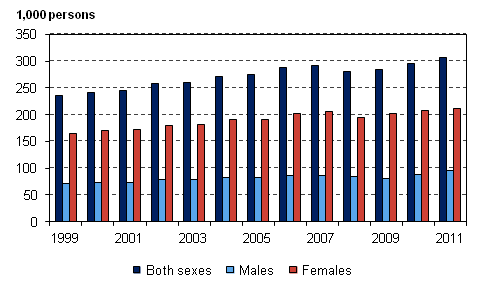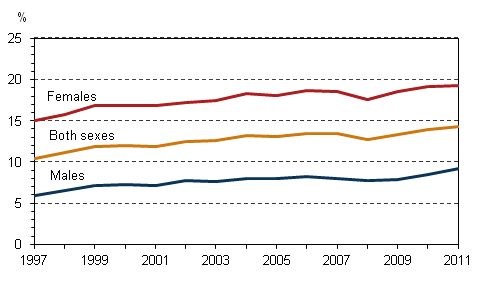5 Number of part-time employees went up slightly
5.1 Number of part-time employees highest in female-dominated industries
According to the Labour Force Survey, 369,000 employed persons worked part-time in 2011. Some 15 per cent of all employed persons worked part time. Of them, 307,000 were employees. The Labour Force Survey data on part-time employment is based on the respondents’ own reporting. The following only concerns part-time employees.
The number of part-time employees grew slightly (+12,000) from the previous year in 2011 Part-time employees made up 14 per cent of all employees in 2011. The long-term trend in part-time employment has been a growing one since 1997. Part-time employment is more widespread among women than men. Persons employed part-time numbered 211,000, or 19 per cent, among female employees and 96,000, or 9 per cent, among male employees. (Figures 13 and 14.)
Nearly three-quarters of the part-time employees worked in the private sector. The numbers of part-time employees were the highest in the female-dominated industries of wholesale and retail trade, and human health and social work activities. The share of part-time employees of all employees was the largest, or 38 per cent, in retail trade (excl. motor vehicle trade).
Figure 13. Part-time employees aged 15 to 74 by sex in 1999–2011

Figure 14. Share of part-time employees among employees aged 15 to 74 by sex 1997–2011, %

5.2 Studying is still the commonest reason for working part-time
Working part-time suits the life situation of many of those who are employed part-time. By contrast, part-time employment can be viewed as one form of underemployment in cases where the employee has not succeeded in finding full-time work even if he/she would have wanted it.
In 2011, studying was again the commonest reason why employees worked part-time. Approximately 28 per cent of part-time employees quoted this reason. Working part-time is most widespread among employees between the ages of 15 and 24 of whom 39 per cent worked part-time in 2011.
Other reported reasons related to life situation were caring for children or relatives, and health reasons. Nearly all of those who reported caring for children or relatives as the reason for working part-time were women. For good one-quarter of part-time employees, the reason for working part-time was that full-time work was not available. In 2011, employees working part-time involuntarily numbered 82,000, of whom 58,000 were women and 24,000 men.
Among the 55 to 64-year old employees, the number of part-time workers was 65,000, which was nearly 18 per cent of all employees in this age group.
Source: Labour Force Survey 2011. Statistics Finland
Inquiries: Kirsi Toivonen 09 1734 3535, Olga Kambur 09 1734 3565, Tarja Nieminen 09 1734 3561, tyovoimatutkimus@stat.fi
Director in charge: Riitta Harala
Updated 9.3.2012
Official Statistics of Finland (OSF):
Labour force survey [e-publication].
ISSN=1798-7857. Employment and unemployment in 2011 2011,
5 Number of part-time employees went up slightly
. Helsinki: Statistics Finland [referred: 11.12.2025].
Access method: http://stat.fi/til/tyti/2011/13/tyti_2011_13_2012-03-09_kat_005_en.html

